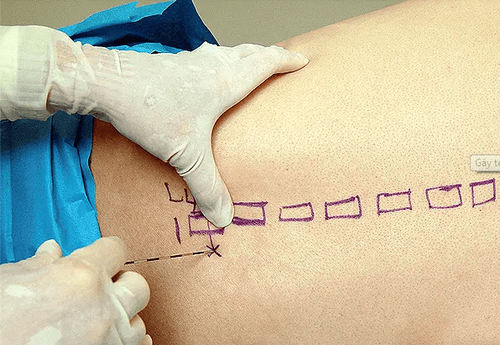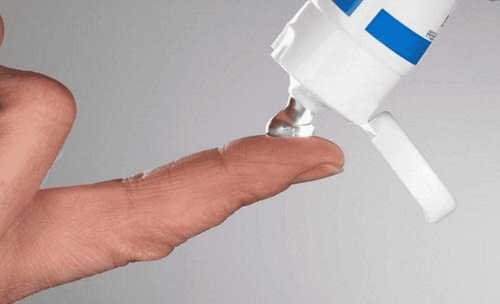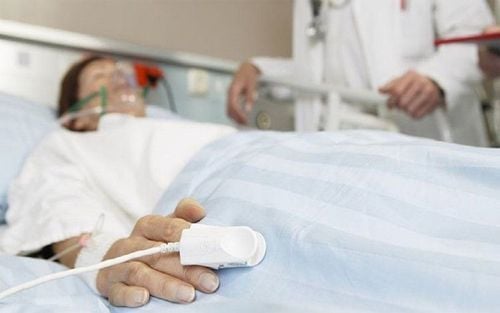This is an automatically translated article.
The article was professionally consulted by Specialist Doctor I Tran Thi Ngat - Department of General Surgery - Vinmec Danang International Hospital.Spinal anesthesia for urethral dilation surgery is a method of inhibiting nerve conduction through the patient's spinal cord. This technique is performed by injecting local anesthetic into the subarachnoid space. Technique Spinal anesthesia for urethral dilation surgery is the best way to help patients relieve pain during urethral dilation surgery.
1. In what cases is spinal anesthesia for urethral dilation surgery indicated?
Spinal anesthesia for urethral dilatation surgery is an anesthetic technique suitable for urethral dilatation surgery because the level of nerve supply ensures the patient is pain-free, has soft muscles, and has little effect on respiratory and circulatory function. . Spinal anesthesia is chosen when there are no contraindications.2. When is spinal anesthesia contraindicated for urethral dilation surgery?
Spinal anesthesia is a suitable indication for urethral dilation surgery, but this technique cannot be used in all cases. Specific contraindications are as follows:First, spinal anesthesia for urethral dilation surgery will not be indicated if the patient refuses. The doctor will respect the patient's opinion and suggest other more suitable methods.
Patients with an allergy to local anesthetics, inflammation of the needle puncture area will not be assigned spinal anesthesia for urethral dilation surgery.
Patients with inadequate volume depletion, shock, severe coagulopathy, constricted mitral stenosis, constricted aortic valve, or raised intracranial pressure.

3. What should the patient prepare before spinal anesthesia for urethral dilation surgery?
First, the patient needs to visit the doctor before surgery, the doctor will explain and provide the procedures for the patient to easily coordinate. Then, the medical staff will clean the anesthetic area, give the patient a sedative the night before (if necessary).4. How to proceed with spinal anesthesia for urethral dilation surgery
Step 1: Prophylaxis of hypotensionThe patient will be placed on an effective intravenous line and given 5-10 ml/kg of fluid as an adult.
Step 2: Patient's position
With spinal anesthesia technique, the patient can be placed in two positions, sitting or lying down. The sitting position requires the patient to sit with the back arched, the head bowed so that the chin rests on the chest, the legs can be placed on the chair or stretched on the operating table. With the lying position, the patient needs to lie on his side with his back bent, his knees must be close to his stomach and his chin should be on his chest.
Step 3: Disinfect and prepare
The patient will have to disinfect the needle puncture area 3 times with an antiseptic solution, then cover with a sterile tissue. Meanwhile, the doctor performing the procedure will have to wear a hat, mask, wash hands, wear a shirt, and wear sterile gloves.
Step 4: Spinal anesthesia technique
Depending on the patient's condition, the doctor can choose midline or lateral anesthesia. During midline anesthesia, a needle is inserted into the space between the two vertebrae, usually L2-L3 to L4-L5. In the case of lateral anesthesia, the needle will be inserted 1-2 cm from the midline, the direction of the needle is in the midline, up and out.
During needle puncture, the bevel of the anesthetic needle should be oriented parallel to the patient's spine. The depth of the puncture is determined when the anesthesiologist feels a loss of resistance as the needle passes through the dura. If there is CSF effusion, the bevel of the needle should be turned towards the patient's head and the anesthetic injection should be performed.

5. Complications and how to manage during spinal anesthesia for urethral dilation surgery
Although very rare, patients can be poisoned by anesthetic if the wrong anesthetic is injected into the blood vessels. At this time, the operator needs to stop using anesthetics, anticonvulsants, respiratory and circulatory resuscitation, intralipid infusion when poisoning with local anesthetics such as bupivacaine and ropivacaine. In case of allergy or anaphylaxis to local anesthetics, patients should immediately stop using local anesthetics and use anti-anaphylaxis regimens according to the Ministry of Health.Some other complications and side effects when spinal anesthesia for urethral dilation surgery are as follows:
Headache: the patient needs to lie motionless, use pain relievers and make enough fluid. Epidural patching with autologous blood is the gold standard for the treatment of headache following spinal anaesthesia. Low blood pressure or slow pulse: Using vasoconstrictor drugs such as ephedrine, adrenaline, atropin... and fluid resuscitation is the best treatment. Nausea and vomiting: treatment should control the patient's blood pressure, possibly using antiemetics if necessary. General spinal anesthesia: This case is quite dangerous, the patient needs emergency respiratory and circulatory resuscitation immediately. Some other complications such as spinal cord injury, blood around the spinal cord, horsetail syndrome, meningitis. These cases require further consultation and investigation to determine the lesion. Spinal anesthesia for urethral dilation surgery is a necessary method when performing urethral dilation surgery. However, if the patient is not suitable for this method, the doctor can also prescribe other methods of pain relief for the patient during surgery.
With the goal of bringing patients the most advanced medical techniques in the world, minimizing complications and risks, Vinmec International General Hospital has applied the ESP technique. This is an analgesia technique that can completely replace analgesia morphine in open heart surgery and thoracic surgery in both adults and children with many outstanding advantages:
Helps to relieve pain comprehensively, without complications, shorten the time of active resuscitation, eliminate the risk of postoperative pain and chronic pain in 96% of heart surgery patients. No direct effect on spinal cord and anatomical structures of nerves Safer due to ultrasound guidance There were no cases of needing to add morphine analgesia when skin incision, sternum saw. Significantly reduce the dose of painkiller Sufentanil during surgery. Pain level after extubation, exercise, and extubation (VAS <3). There were no complications of hematoma, hypotension or excessive anesthesia, respiratory depression, anesthetic toxicity. Dr. Ngat has more than 15 years of experience as an Anesthesiologist and resuscitator at Hospitals: Da Nang Obstetrics and Gynecology Hospital, Hospital 199 of the Ministry of Public Security, Tam Tri Hospital in Da Nang. Currently, he is an anesthesiologist at the Department of General Surgery - Vinmec Da Nang International General Hospital.
Please dial HOTLINE for more information or register for an appointment HERE. Download MyVinmec app to make appointments faster and to manage your bookings easily.














